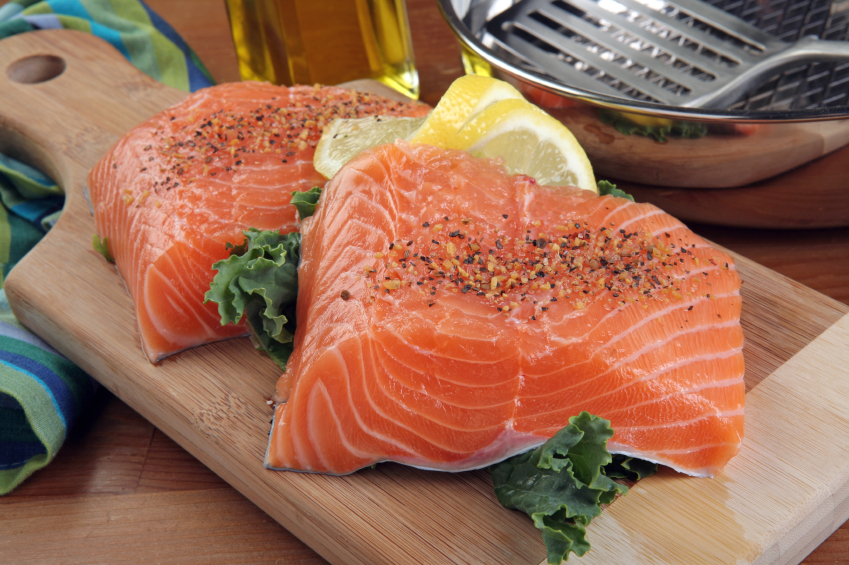Today’s Recipes: Cold Poached Salmon, Cucumber-Lemon-Dill Sauce, Dill-Dijon Whipped Cream, Lemon Dill Butter Sauce, and Pesto Creme Fraiche.
When I was in the sixth grade my father got transferred to Portland, Oregon. My family moved up and for most of a year we got to live in one of the most beautiful places in the country. It was one of the coldest winters in recent memory, and we loved every minute of it. My father had a friend who loved to go deep-sea fishing in Alaska. He brought back freshly caught Coho salmon and for the first time in my life I experienced how delicious fresh fish can be. A few years later I went to a Sunday Brunch and was served cold poached salmon. I fell in love all over again – this time with the cold presentation.
Very simply prepared with lemon, salt, and pepper, I could not get enough of it. I ate as much as they would let me and still wanted more. It was the beginning of my love affair with fresh salmon. Full of vitamins, protein, and cancer-fighting Omega-3 fatty acids, it is one of the best foods for us.
When you are cooking salmon filets, they usually have a thicker portion in the center and are quite thin on the edges. To make sure everything cooks at the same rate, fold the thin section under to double its thickness.
Dill and cucumber complement any seafood but especially salmon. You can make any of the sauces to accompany the poached fish, or serve several. People love to have choices. Salting the cucumber isn’t required, but it does remove a lot of the cucumber’s natural moisture giving you a drier sauce. If you want, you can skip that step. Just be prepared for the sauce becoming wetter as it sits.
One of the big topics in food circles today is the protection of wild and sustainable seafood. The decline in spawning salmon is well documented and a serious concern. One way you can help is to purchase sustainably harvested wild Alaskan salmon from a reputable fishmonger. Another way is to follow the guidelines of the Monterey Bay Aquarium’s Seafood Watch program when you purchase your seafood.
Seafood Watch encourages restaurants, distributors, and seafood purveyors to purchase from sustainable sources. Their recommendations are based on extensive scientific research and are designed to help sustain wild, diverse, and healthy ocean ecosystems. The viability of the oceans is something we can improve, and with perseverance, reverse our destructive practices. Seafood Watch puts out pocket guides each January that are regionally based, which breaks down the available fish into three categories; Best Choices, Good Alternatives, and Avoid. Keeping this card with you when you shop will help you make the best decisions.
As of May 2010 the Best of the Best List includes Salmon (wild-caught, from Alaska). The Seafood Watch website is full of interesting and useful information and items you can download. Take a few minutes and check it out.
Jane’s Tips and Hints:
When you are buying seafood, look for whole fish with the heads still on. You want the eyes to be clear and not cloudy which increases the older the fish is. Ask you fish monger what they got in fresh that day and choose from those offerings. It should never smell fishy, but like the ocean.
Kitchen Skill: Poaching
Why: To cook foods in a slow and gentle liquid bath
How: Create a flavorful liquid by infusing water or broth with fresh herbs and aromatics. Simmer it lightly for about 10 minutes then add the food to be poached. Cover and let is cook gently until just done. Your protein will be tender and moist, perfectly cooked.


- Court Bouillon
- 2 cups dry white wine
- 2 cups water
- 4 lemon slices
- 1 small onion, peeled and quartered, and studded with 2 whole cloves
- 5 sprigs parsley
- 1 bay leaf
- 10 whole peppercorns
- Salmon
- 1 (3 lb) salmon fillet, skin on, scaled and pin bones removed, about 1/2 inch thick at the thickest point
- Salt and freshly ground pepper
- Garnishes
- Fresh dill sprigs
- Fresh lemons
- Combine all ingredients in a medium skillet or saucepan. Bring to a boil then reduce to a simmer. Let simmer for 3 to 5 minutes to develop flavors.
- Sprinkle the salmon with salt and pepper on both sides, add to simmering liquid, and cover. Cook for 5 to 8 minutes or until just done. Transfer carefully to a platter using large spatulas. Cover and chill thoroughly. Discard the poaching liquid.
- Serve salmon, skin-side down, chilled or at cool room temperature with your choice of sauces and fresh lemon wedges. Garnish with fresh dill sprigs and lemons.
- Yield: about 6 to 10 servings
- 1/2 cup peeled, seeded, & finely chopped cucumber
- 1/2 cup low fat sour cream
- 1/2 cup low fat Greek yogurt
- 1 tbsp freshly squeezed lemon juice, or to taste
- 1 shallot, peeled and very finely minced
- 2 tsp chopped fresh dill
- Salt and white pepper to taste
- Place cucumber in a colander and sprinkle lightly with salt. Set aside to drain for about 10 minutes. Pat dry with paper towels and brush off any excess salt.
- In a medium bowl, combine the sour cream, yogurt, lemon juice, shallots, and dill. Fold in the cucumber. Cover and chill in refrigerator for about 30 minutes. Taste and adjust seasonings with salt and pepper.
- 1 cup creme fraiche
- 1/3 to 1/2 cup prepared basil pesto
- A little heavy cream
- 1/2 tsp prepared horseradish, optional
- Combine all ingredients. Taste and adjust seasonings as needed.
- 1/2 cup heavy cream
- 1 tbsp Dijon mustard
- 2 tsp fresh dill, chopped
- Salt and pepper
- Whip cold heavy cream with an electric mixer on high until soft peaks form. Add the mustard and continue beating on medium for about 1 minute or until medium peaks form. Fold in the dill and season with salt and pepper to taste.
- 3/4 cup dry white wine
- 3 tbsp chopped shallot
- 2 tbsp fresh lemon juice
- 1 stick (1/2 cup) chilled unsalted butter, cubed
- 1-1/2 tbsp fresh dill
- Salt and pepper to taste
- Boil wine, shallots and lemon juice over high heat until reduced to 1/4 cup (about 6 minutes). Reduce heat to low; add butter, one piece at a time, whisking until melted before adding more. Remove pan from heat. Stir in dill. Season to taste with salt and pepper.
- Makes about 3/4 cup
Thank You!










freshly picked lemons
Thank you for this post. You must not only be an accomplished chef but also an accomplished photographer. Boy, I learned a lot reading your blog. Where do you get all this terrific information? YOU are bookmarked! Your post is loaded with a lot of good information and very instructive. I’m worried about salmon though. I’m worried about Omega 3. I’m worried that the loss of salmon will drive up the price of fish oil and Omega 3. I read that salmon supplies are already diminishing at http://www.order-salmon.com/salmon-global-warming-salmon-climate-change.php It says that the oceans are becoming more acidic because we are dumping so much carbon dioxide into the air and that this endangers the food that salmon feed on. What do you know about this? What can we do about it? What can one person do?
Susan
Jane Bonacci, The Heritage Cook
Hi Susan, I share your concerns. You can contact your local politicians and let them know how you feel, you can support global warming initiatives, but probably the best way everyone can help is to support sustainable fish providers. Speak with your dollars! Help spread the word by posting articles like the one above and get people talking. Order or print out copies of the Monterey Aquarium Seafood Watch Pocket Guides and give them to your family and friends. Buy from the Green list. Talk to your fish monger and ask them to sell responsible options. One person can make a difference!
Thank you for taking the time to share your thoughts. I hope you come back to the blog often!
Yoshiko
Hello! I do not go onto Facebook a lot, but I happened to catch your recent post, and your website! What a wonderful site it is!
I love fish, but have not prepared it much in the past. Now that I am living in Turkey, where the fish is the freshest I have ever seen it (I am hoping to go to the Tsukiji fish market in Tokyo in February; maybe it will rival!), I am trying to prepare it more often. The fish here is mostly sold as a whole; the fishmongers clean and fillet to order, which is really nice.
I have never had poached salmon before, grilling and broiling being the preferred cooking methods in a Japanese household. But my go-to method for cooking fish is now “en papillote” – putting fish pieces in parchment or aluminum packets and popping it in the oven to cook in its own little steam bath. For seasonings, I have added lemon, cream, herbs, and whatever I have in the pantry that sounds like it may go well. The fish always comes out perfect, moist and flavorful.
I will have to try this poaching method when I come across salmon! Thank you for the lovely post!
Jane Bonacci, The Heritage Cook
Thank you Yoshiko! I didn’t realize you were living in Turkey, what an amazing experience! Cooking fish en papillote is fantastic and one of my favorite methods. I know you will love poached fish – you can cook any fish in this manner – it is so tender and moist! And unlike other cooking methods, it won’t leave your home smelling like fish for three days, LOL!
kids dentist thousand oaks ca
I am just crazy about your poached salmon recipe. You mentioned “To make sure everything cooks at the same rate, fold the thin section under to double its thickness.” Thanks for that tip. Extremely good one.
Do you recommend using wild salmon or farmed? Some favor farmed salmon because it is cheaper. However, I have also read that wild salmon has higher Omega-3 content and astaxanthin in it. I live in a remote area so it’s not easy to find decent salmon so I end up ordering it online. But I never know what kind to buy? Should I buy Atlantic salmon? Or Pacific salmon? Or Alaskan salmon. Or should I order farmed salmon or wild salmon? I read at http://www.order-salmon.com that Sockeye salmon is one of the best kinds of salmon you can eat because of its higher Omega-3 content.
Looking forward to your response.
Joanne
Jane Bonacci, The Heritage Cook
Hi Joanne,
What a wonderful series of questions! I always recommend Wild Alaskan Salmon if you have the choice. The Monterey Bay Aquarium’s Seafood Watch is the guideline everyone should follow.(See the links above.) Buying wild fish helps support keeping our oceans and rivers clean and healthy for the seafood that lives there. In terms of Omega-3’s, cold water fish have the highest levels. The fish with the highest levels are Salmon, Mackerel, Herring, Lake Trout, Sardines, and Albacore Tuna. You can get additional information from the American Heart Association at http://www.heart.org/HEARTORG/GettingHealthy/NutritionCenter/Fish-101_UCM_305986_Article.jsp.
I am very glad to welcome you to the Heritage Cook and hope you come back often!